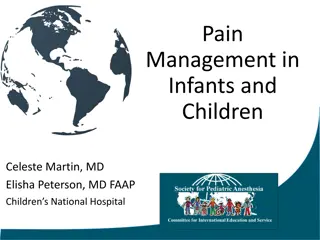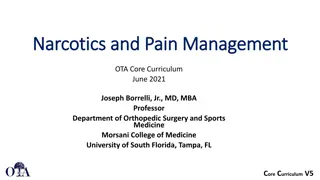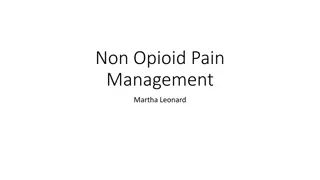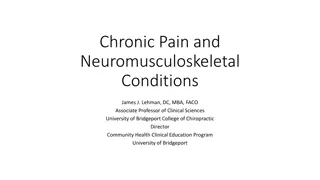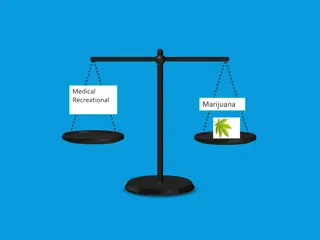Marijuana for Persistent Pain: A Thoughtful Approach
Exploring the use of marijuana for persistent pain management, Dr. Launette Rieb discusses cannabinoid neurochemistry, health risks, and current guidelines. The session covers the endocannabinoid system, cannabis properties, and parallels with tobacco, emphasizing the impact of mood-altering substances on pain relief.
Download Presentation

Please find below an Image/Link to download the presentation.
The content on the website is provided AS IS for your information and personal use only. It may not be sold, licensed, or shared on other websites without obtaining consent from the author.If you encounter any issues during the download, it is possible that the publisher has removed the file from their server.
You are allowed to download the files provided on this website for personal or commercial use, subject to the condition that they are used lawfully. All files are the property of their respective owners.
The content on the website is provided AS IS for your information and personal use only. It may not be sold, licensed, or shared on other websites without obtaining consent from the author.
E N D
Presentation Transcript
Marijuana: Is it appropriate for the treatment of persistent pain? Launette Rieb MD, MSc, CCFP, FCFP, dip ABAM Clinical Associate Professor, UBC Thoughtful Approach to Chronic Pain. Medford, Oregon, May 28-30, 2015
Faculty/Presenter Disclosure Faculty: Launette Rieb Relationship with commercial interests: No commercial interests
Disclosure of Commercial Support No financial support or in-kind support for this program No potential conflicts of interest for Dr. Rieb
Mitigating Potential Bias There is no bias to mitigate due to commercial interest Any bias I may have comes from treating thousands of people with addiction and pain conditions
Learning objectives Highlight cannabinoid neurochemistry Summarize adverse health risks Overview literature on cannabinoids for medical use, focus on pain Review new CFPC guidelines for dried cannabis prescribing including indications, contraindications
Parallel with Tobacco Free of legislation Criminalization Medicalization Decriminalization Legalization and taxation Health consequences studied Leading cause of preventable death Campaigns to curtail initiation and use
Endocannabinoids Endogenous cannabinioids: Anandamide and others CB1 receptors central CB2 peripheral Plant makes THC, binds to receptors
Cannabis Cannabis sativa class - hallucinogen 400+ chemicals 70+ cannabinoids -9-Tetrahydrocannabinol ( THC ) Binds to CB1 and CB2 receptors Dopamine which reinforces use Stimulant & depressant Psychotropic
Remember All mood altering substances can reduce pain while intoxicated All substances (including pain medications) that cause dopamine release in the misolimbic system can be overvalued even in the absence of true addiction hence the emotional attachment around discussing opioids, cannabinoids, benzos, etc. with patients
THC vs CBD Cannabidiol (CBD) produced by plant Protective against psychosis, anxiolytic As the marijuana THC content goes up, the CBD content goes down In 1960s marijuana had 2-3% THC and CBD Now THC can be up to 25% & CBD near 0 Some strains have high CBD and low THC
Increasing Potency of Marijuana (% -9 THC) 16 14 12 % 10 8 -9 THC 6 4 2 0 SOURCE: University of Mississippi Marijuana Project
Cannabinoids Nabilone synthetic delta 9 THC Dosing 0.25 - 4mg/d divided tid to qid Does not show up on urine drug screen Approved in Canada: Chemotherapy induced N+V Nabiximols plant extract of delta-9- tetrahydrocannabinol 2.7 mg and cannabidiol 2.5 mg in an oro-mucosal spray Dosing 1-12 sprays/d divided tid to qid Approved in Canada and UK for advanced cancer pain, MS associated pain and spasticity
Cannabiniods, contd Dronabinol - delta-9-THC 2.5-20 mg/d in divided dosing tid to qid Approved in Canada: For chemotherapy induced N+V, and for anorexia associated with HIV/AIDS Ingested marijuana Usually about 1/3 more than smoked, baked Harder to titrate than smoked, but longer lasting Smoked marijuana = dried cannabis Patients use huge range few puffs to many grams/d This is why guidelines have been developed Health Canada exemption, many states in US have marijuana for medical purposes exemptions
Pharmacokinetics Inhalation Peak effect 10-30 min, duration 2-3+ h Oral Ingestion Peak effect 1-2 h, duration 4-6+ h First pass hepatic metabolism Highest [THC] found in heart & fat Metabolism by cytochrome P450 Half-life 2-60 h Excretion 1/3 urinary, 2/3 fecal UDS: Single use 5-7+ d, chronic use 45+ d
Adverse Health Effects of Marijuana Use - Volkow N, et al. 2014 Short term: Impaired memory, making it difficult to learn Impaired motor coordination, impairing driving, injury Altered judgment, risk of STIs, Paranoia and psychosis in high doses Long term: Addiction Altered brain development Poor educational outcomes, cognitive impairment, IQ Diminished life satisfaction and achievement Chronic bronchitis psychotic disorder risk (including schizophrenia)
Adverse Health Effects -details Acute Dry mouth, conjunctival injection BP, HR, arrhythmias Decreased exercise time to onset of angina(Aronow, 1974) Attention, motivation, memory, false novelty, paranoia, derealization, hallucinations THC anxiety, acute psychosis; CBD may anxiety (Fusar-Poli 2009) Altered depth perception, coordination, driving impairment (Robbe, 1998)
Adverse Health Effects Chronic Risk of COPD (Tan, 2009) Brain changes: Heavy daily users 5+ joints/d: hippocampal and amygdala volume (Yucel, 2008) Lowers IQ: If initiation prior to age 18 - IQ does not recover when detoxed; if adult initiation, can normalize, continued use can add to neurocognative decline with aging (Meier, 2012) Risk of psychotic disorder - dose dependent, age dependent, genetically influenced (VM=2x, VV=10x), CBD may be protective (Andereasson 1987, and Zammit 2002, Henquet 1995, Caspri, 2005) Hormonal effects testosterone, LH and FSH Risk of cannabis use disorder = addiction (9% users, 17% if began <age 18, 25-50% of daily users) Risk of diversion
Addiction: About 9% of users may become dependent ~1 in 6 who start in adolescence, and 25-50% of daily users Estimated Prevalence of Dependence Among Users 35 32 30 23 25 Percent 20 17 15 15 11 9 8 10 5 5 0 * * (NESARC data collected 2001-2005, Lopez-Quintero et al., 2011) * Nonmedical Use Source: Anthony JC et al., 1994
Source of Marijuana* among 12th Graders in 2012 and 2013, by State Policy 100 Medical Marijuana States Non-Medical Marijuana States 80 60 % 40 ** 20 ** 0 *Categories not mutually exclusive ** Statistically significant difference SOURCE: University of Michigan, 2013 Monitoring the Future Study
Estimated Relative Risk of Death from Illicit Drugs Opioids 14.7 Cocaine 4.7-7.6 Amphetamines 6.2 Cannabis 1 (Dagenhardt & Hall, 2012) Note: Cannabis deaths likely underestimated (e.g. motor vehicle accidents & respiratory disease)
Potential Medical Uses Antiemetic: Effective chemo N+V (Sallan 1975); beware of rebound N +V or hyperemesis with use Appetite stimulant in HIV/AIDS: evidence lacking on Cochrane Review (Lutage 2014) Antispasmodic for MS: Reduced patient reported spasticity with oral whole plant extract (nabiximols)(Wade 2010, AAN.com/guidelines)) Anticonvulsant and for HD: insufficient evidence (AAN.com/guidelines) Glaucoma: Modest intraocular pressure of short duration (2-4 h), followed by rebound hypertension. Chronic use leads to tolerance of IOP effect (Jones et al,1981) Topical synthetic cannabinoids may decrease IOP (Porcella, 2001)
Analgesia Possible mechanisms: Via CB1 and CB2 receptor activation modulates nociceptive responses (Chiou, 2013) Amygdala activity contributes to the dissociative effect of cannabis on pain perception (Lee, 2013)
Systematic Review and Meta- analysis of Cannabis Treatment for Chronic Pain Martin-Sanchez et al. Pain Medicine Vol 10 (8) 2009: 1353-1368 Double blind RCTs comparing any cannabis preparation to placebo in pts with chronic pain (>6mo) published to Feb 2008 18 studies included
Meta-analysis of cannabis for CP Baseline=0, scale: -10 to +10 Efficacy -0.61 SMD (-0.84 to -0.37), modest Altered perception OR: 4.51, NNH: 7 Altered motor fxn, OR: 3.93, NNH: 5 Altered cognitive fxn, OR: 4.46, NNH: 8 Beneficial effects may be partially (or completely) offset by potentially serious harms
Cannabis and Prescribed Opioids Reisfield et al. Pain Medicine Vol 10 (8) 2009: 1434-1441 Systematic review of published studies on patients using opioids for CNCP that looked at aberrant drug related behavior and UDS results Cannabis use is prevalent: 6.2 - 39% in pain pop. Cannabis use - Significant association with present and future aberrant opioid related behaviors diversion, cocaine in UDS, prescription forgery, no opioid in UDS 6x more likely to have the above behaviors than someone on opioids not using cannabis
Neuropathic Pain - Review Lynch ME, Cambell F. Cannabinoids for the treatment of chronic non-cancer pain: A systematic review of randomized trials. Br J Clin Pharmacol. 2011 Nov; 72(5); 735-744 Systematic review of RCTs on cannabinioids for CNCP 2003-2010 Of 80 studies, 18 meet PRISM criteria, 15 neuropathic pain, 766 people combined, 2 1/2 wks: 4 smoked cannabis, 7 oro-mucosal extracts, 4 nabilone, 2 dronabinol, 2 ajulemic acid. NNT varied. Modest effect in neuropathic pain Preliminary evidence of efficacy in fibromyalgia and rheumatoid arthritis
Neuropathic Pain - CPS Moulin et al. Pharmacological management of chronic neuropathic pain: Revised consensus statement from the Canadian Pain Society. 2014 1st line: TCAs, SNRIs, gabapentinoids 2nd line: tramadol, other opioids 3rd line: cannabinoids oromucal nabiximols Note: Does not recommend smoked cannabis 4th line: methadone, lidocaine
Diabetic Neuropathy Snedecor et al. Systematic Review and Meta- Analysis of Pharmacological Therapies for Painful Diabetic Peripheral Neuropathy. Pain Practice (2014)Volume 14, Issue 2, 167 184 Oro-mucosal nabiximols scored worse than placebo for pain relief
Neuropathic pain Finnerup N, et al. Pharmacotherapy for neuropathic pain in adults: A systematic review and meta-analysis. Lancet-neurology (2015) vol 14, Feb. 162-172 Identified 9 trials of nabiximols in neuropathic pain and only 2 were positive Thus the authors made a weak recommendation AGAINST use of cannabinoids for neuropathic pain
So what is the evidence for smoked cannabis? 5 RCTs on smoked cannabis Total subjects = 180 Duration range 3-15 days Subjects had severe neuropathic pain from MS or HIV or other causes The trials compared smoked cannabis to placebo and had modestly positive results One trial that compared smoked cannabis to dronabinol dronabinol had a longer duration of analgesia
Dried Cannabis Guidelines from College of Family Physicians of Canada (CFPC): Kahan M, et al. 2014 Disclaimer: Dried cannabis differs from prescribed products in that Health Canada has not reviewed data on its safety or effectiveness and has not approved it for therapeutic use. CMA and CMPA does not endorse its use. Prescribe with discretion or not at all.
Indications for smoked cannabis Severe neuropathic pain, not responding to other treatments including oral cannabinoids NOT indicated for MSK pain
Recommendation 3 Dried cannabis is not an appropriate therapy for anxiety or insomnia (Level II)
Recommendation 4 Dried cannabis is not appropriate for patients who: a) Are under the age of 25 (Level II) b) Have a personal history or strong family history of psychosis (Level II) c) Have a current or past cannabis use disorder (Level III) d) Have an active substance use disorder (Level III) e) Have cardiovascular disease (angina, peripheral vascular disease, cerebrovascular disease, arrhythmias) (Level III) f) Have respiratory disease (Level III) or g) Are pregnant, planning to become pregnant, or breastfeeding (Level II)
Recommendation 5 Authorized with caution in those patients who: a) Have a concurrent active mood or anxiety disorder (Level II) b) Smoke tobacco (Level II) c) Have risk factors for cardiovascular disease (Level III) or d) Are heavy users of alcohol or taking high doses of opioids or benzodiazepines or other sedating medications prescribed or available over the counter (Level III)
Recommendation 8 Before signing a medical document authorizing dried cannabis for pain: a) Conduct a pain assessment (Level II) b) Assess the patient for anxiety and mood disorders (Level II) c) Screen (including urine drug screen) and assess the patient for substance use disorders (Level II)
Recommendation 10 Patients taking dried cannabis should be advised not to drive for at least: a) 4 hours after inhalation (Level II) b) 6 hours after oral ingestion (Level II) c) 8 hours after inhalation or oral ingestion if the patient experiences euphoria(Level II)
Harm Reduction Advice Use vaporizer instead of joint or pipe Much lower levels of carbon monoxide Don t mix with tobacco Caution with alcohol, opioids, and other drugs Don t breath hold Caution with edibles
****Dosing**** Dried cannabis 400-700 mg is the daily amount needed for analgesia according to the literature you may choose not to go above this Typical maximum amount would equal about 1 joint (500mg) per day, divided into a puff or two 3-4x per day Highly tolerant individuals may require 1g and rarely 3 g /d (but not eligible if they have a cannabis use disorder - beware if a daily smoker prior to injury) Start with 1 inhalation before bed, go slow
****Dosing**** Prescribing Document used should specify dose, percent THC, days, and amount dispensed: Dried cannabis 500 mg/day, 9% THC maximum, for 30 days, dispense 15 g Not clear if producers have to honor 9% THC direction but important to list You can callback the patient for med check
Monitoring See patient weekly to biweekly until dose established Then monthly monitoring x three to six months before visits every 1- 3 months Include an agreement, monitor for psychiatric symptoms, cannabis use disorder, functional changes Do random urine drug screens for THC and other addictive substances
Discontinuation Taper off If no functional benefit is derived If impaired in the office If psychotic symptoms appear If driving under the influence If safety sensitive work or play impaired If diverting
Thanks Questions?









